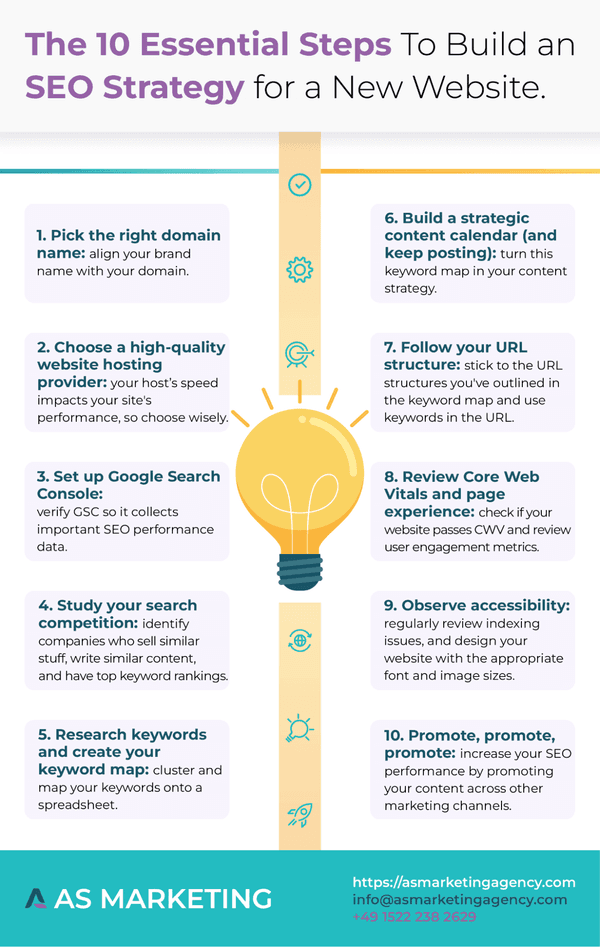Explore the World's Best Ideas
Join today and uncover 100+ curated journeys from 50+ topics. Unlock access to our mobile app with extensive features.
How to Prep Your SEO Strategy for a New Website
From web development to branding and design, there are plenty of moving parts when launching a new website, but your SEO strategy shouldn’t be an afterthought.
In fact, your SEO strategy should be one of the primary considerations before you even start your website. To take things a step further, the best case scenario would be that your website structure is fully built based on the SEO strategy you already have in place. Doing this from the get-go saves lots of headaches for things like web development, content formatting and design, URL structures, and more.
18
113 reads
Why is SEO valuable for new websites?
New websites have no indexed pages, don’t have backlinks, and thus also have no authority.
As time presses on, Google starts to sniff out and apply changes as your website matures (assuming the SEO strategy is done right), and you’ll soon see that there are some other websites to contend with.
A new website can start by focusing on longtail, low-competition keywords until it works its way up. Over time, with proper SEO strategies, your new website can grow to compete and even overtake the strongest of competition.
15
100 reads
1. Pick the right domain name (you can’t change it after!)
The right domain name is associated with SEO equity, so aligning your company and brand name with your domain name is critical. When you have a new domain, you’re essentially starting your SEO from scratch.
15
106 reads
2. Choose a high-speed website hosting provider
The average user won’t wait longer than three seconds for a website to load, so ensuring an excellent host is the first step of your SEO strategy.
14
94 reads
3. Set up Google Search Console
It’ll provide you with tons of that that you need to achieve SEO success. With Google Search Console, you can check things like:
- Page speed issues
- Organic keywords that bring in website clicks
- Your average click through rate (CTR)
- Sitemap submission
- Crawl and index errors
- Page performance
18
85 reads
4. Study your SEO competition
When analyzing and making a list of your competitors consider these questions:
- How is their company similar to yours? How is it different? Check out their unique selling points.
- What topics do they write about?
- What keywords are they already ranking for?
Every business has product and service competitors, but that doesn’t mean they have an SEO strategy that’s worth trying to outperform. The key here is to identify who sells similar stuff, writes similar content, and is piling up top keyword rankings. Those are your “SEO competitors”, and they’re who you want to beat.
16
67 reads
5. Research keywords and create your keyword map
Keywords connect search queries to your content listed in the SERPs.
Google’s goal is to use the keywords used in search queries to identify & present the most valuable information to searchers, aka “search intent”.
Longtail, low competition keywords that exactly match what you’re selling, are your direct path to ensuring SEO has a major impact on your revenue & long-term profitability.
Understanding search intent plays a major role with buyer journey stages, so ensuring that you’re crafting content that’s appropriate for buyers in the awareness, consideration, & decision stage is crucial.
15
72 reads
6. Build a strategic content calendar (and keep posting)
- Prioritize sections of your keyword map: Such as product or service pages, as those have the highest likelihood to result in conversions and generate revenue for your business.
- Optimize your content: Don’t forget to use keywords in the H1, URL, and metadata.
- Track your keyword rankings: Once you publish content, keep an eye on how it’s performing. Content can move up over time as Google perceives your content to be trustworthy, you provide a good user experience, & your Domain Authority increases.
- Post consistently: Publish at least 4 new website pages per month.
15
63 reads
7. Ensure an optimized URL structure
Putting keywords in your URL is super important for ensuring that your content is being set up properly.
In the words of Rand Fishkin, “if there’s other keywords you haven’t used, or URLs you haven’t targeted with certain keywords, you do so during this process. This way you’re covering your tracks, making certain there are words and phrases that are covered early on.”
14
49 reads
8. Review Core Web Vitals and page experience
Just like you go to check your core vitals at the doctor, you should do the same for your website to steer clear of any unnecessary issues.
SEO is no longer just about putting keywords in the right places, it now also involves content format, design, page load speed, as well as user behavior — like time on page and bounce rates.
In a nutshell, sustainable SEO success no longer ends with the click, you have to wholeheartedly satisfy your readers while they’re on the page in order to consistently rank.
14
52 reads
9. Observe accessibility
Accessibility simply means how easy it is for users (and search engines) to access the information on your website. This element is taken into consideration as a ranking factor. You want an accessible site for everyone, right? Of course, you’ll want to make sure that your content is being indexed and crawled correctly, but you can also take these steps to ensure that happens:
- Optimize alt text in images (for screen readers)
- Use enough contrast (make sure your colors are easy on the eye)
- Correctly label elements like buttons
- Make your font size big enough to read
14
39 reads
10. Promote
Whether for SEO or not, your website content shouldn’t just be published and sit there. The phrase “build it and they will come” is completely untrue when it comes to SEO.
You have put in the effort to create your content, so it deserves to be shown to your audience. Think about where you already have a strong presence and harness that.
15
57 reads
IDEAS CURATED BY
Digital Marketer Welcome to my Deepstash where I share ideas I find most valuable for those who wish learn more about digital marketing!
Madhav 's ideas are part of this journey:
Learn more about marketingandsales with this collection
The importance of networking in podcasting
How to grow your podcast audience
How to monetize your podcast
Related collections
Similar ideas
26 ideas
12 ideas
6 ideas
Read & Learn
20x Faster
without
deepstash
with
deepstash
with
deepstash
Personalized microlearning
—
100+ Learning Journeys
—
Access to 200,000+ ideas
—
Access to the mobile app
—
Unlimited idea saving
—
—
Unlimited history
—
—
Unlimited listening to ideas
—
—
Downloading & offline access
—
—
Supercharge your mind with one idea per day
Enter your email and spend 1 minute every day to learn something new.
I agree to receive email updates

